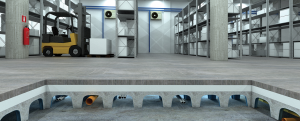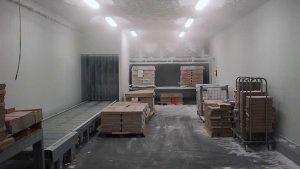Frosty Vaults: Inside Cold Storage Facilities
The Importance of Cold Storage Facilities
Cold storage facilities play a critical role in preserving perishable goods, ensuring their freshness and quality are maintained from production to consumption. These specialized warehouses maintain low temperatures to inhibit microbial growth, slow enzymatic reactions, and prevent spoilage, extending the shelf life of various products. Frosty Vaults: Inside Cold Storage Facilities
Preservation of Perishable Goods
Perishable goods such as fruits, vegetables, dairy products, meats, and pharmaceuticals are highly susceptible to deterioration caused by temperature fluctuations. Cold storage facilities provide a controlled environment where temperatures are maintained at levels ideal for preserving the quality and safety of these items. By slowing down the rate of deterioration, cold storage helps minimize waste and ensures a consistent supply of fresh products to consumers.
The Functionality of Cold Storage Facilities
Cold storage facilities are equipped with specialized refrigeration systems designed to maintain precise temperature and humidity levels. These systems utilize advanced technology to monitor and regulate conditions within the facility, ensuring optimal storage conditions for different types of products. Additionally, cold storage facilities often incorporate insulation materials and air circulation systems to further enhance temperature control and energy efficiency.

Refrigeration Systems
The heart of any cold storage facility is its refrigeration system. These systems typically utilize compressors, condensers, evaporators, and refrigerants to remove heat from the storage area, maintaining temperatures at desired levels. Advanced refrigeration technologies such as variable frequency drives (VFDs) and computerized control systems enable precise temperature regulation, energy efficiency, and remote monitoring of facility operations.
Insulation and Air Circulation
To minimize heat transfer and maintain consistent temperatures, cold storage facilities are constructed with high-quality insulation materials such as polyurethane foam or fiberglass. Additionally, efficient air circulation systems distribute cold air evenly throughout the storage area, preventing temperature stratification and ensuring uniform cooling of products. Proper insulation and air circulation not only help maintain product quality but also contribute to energy savings by reducing the workload on refrigeration equipment.
Applications of Cold Storage Facilities
Cold storage facilities cater to a wide range of industries, including agriculture, food processing, pharmaceuticals, and logistics. These facilities serve as essential links in the supply chain, facilitating the storage and distribution of temperature-sensitive products across various sectors.
Food Industry
In the food industry, cold storage facilities play a crucial role in preserving the freshness and safety of perishable food items throughout the supply chain. From farm to fork, these facilities ensure that fruits, vegetables, meats, dairy products, and frozen foods remain at optimal temperatures, preserving their nutritional value and extending their shelf life. Cold storage also enables food manufacturers to maintain inventory levels and meet fluctuating consumer demands year-round.
Pharmaceutical Storage
Pharmaceutical products, including vaccines, biologics, and medicines, require strict temperature control to maintain their potency and efficacy. Cold storage facilities equipped with temperature monitoring and alarm systems provide a secure environment for storing pharmaceuticals, ensuring compliance with regulatory requirements and safeguarding public health. These facilities play a critical role in the storage and distribution of life-saving medications, especially those requiring refrigeration or freezing.
Logistics and Distribution
In logistics and distribution, cold storage facilities serve as hubs for storing and transporting temperature-sensitive goods. Whether it’s fresh produce, seafood, floral products, or temperature-sensitive chemicals, these facilities provide a reliable infrastructure for maintaining product integrity during transit. Advanced logistics technologies such as real-time tracking, inventory management systems, and temperature-controlled vehicles further optimize the efficiency and reliability of cold chain logistics operations.
The Future of Cold Storage Facilities
As global demand for perishable goods continues to rise and supply chains become increasingly complex, the role of cold storage facilities becomes more critical than ever. Advancements in refrigeration technology, sustainable design practices, and digitalization are shaping the future of cold storage, driving efficiency, reliability, and environmental sustainability.
Technological Innovations
Emerging technologies such as Internet of Things (IoT) sensors, artificial intelligence (AI), and blockchain are revolutionizing cold storage operations. IoT sensors monitor temperature, humidity, and other environmental parameters in real-time, enabling proactive maintenance and ensuring compliance with regulatory standards. AI-powered analytics optimize storage conditions, predict equipment failures, and optimize energy usage, enhancing operational efficiency and reducing costs. Blockchain technology provides transparent and tamper-proof records of product provenance, ensuring the integrity and safety of perishable goods throughout the supply chain.
Sustainability Initiatives

Cold storage facilities are increasingly adopting sustainable practices to minimize their environmental footprint. Energy-efficient refrigeration systems, renewable energy sources, and eco-friendly refrigerants are being employed to reduce energy consumption and greenhouse gas emissions. Additionally, initiatives such as waste heat recovery, thermal insulation upgrades, and LED lighting retrofitting further enhance energy efficiency and operational sustainability. By prioritizing environmental stewardship, cold storage facilities not only reduce operating costs but also contribute to a more sustainable future for the planet.
Digital Transformation
The digitalization of cold storage operations is streamlining processes, improving visibility, and enhancing collaboration across the supply chain. Cloud-based inventory management systems, electronic data interchange (EDI), and automated logistics platforms enable seamless communication and coordination between suppliers, manufacturers, and distributors. Real-time tracking and monitoring of product movement enhance traceability and transparency, ensuring compliance with food safety regulations and customer requirements. By embracing digital transformation, cold storage facilities are poised to meet the evolving needs of a dynamic and interconnected global economy. https://commgen.com.au/contact-us/
Conclusion
Cold storage facilities are indispensable assets in modern supply chains, enabling the safe and efficient storage of perishable goods across various industries. With advanced refrigeration technology, sustainable practices, and digital innovation, these facilities continue to evolve to meet the demands of a rapidly changing world. As we look to the future, the role of cold storage facilities will remain pivotal in ensuring the availability, quality, and safety of temperature-sensitive products for consumers worldwide.

Recent Comments